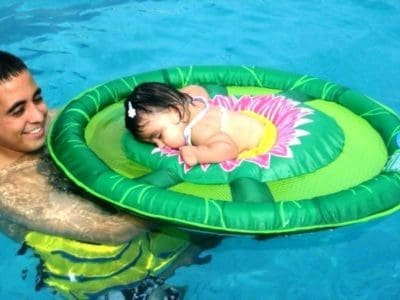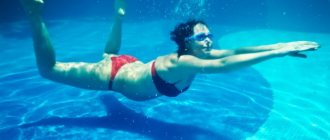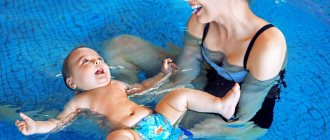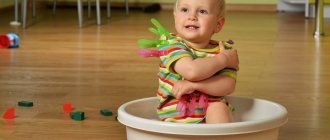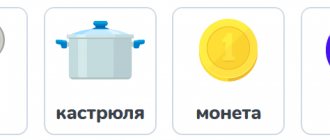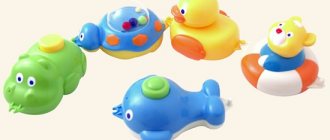Benefits and indications
In the uterus, the child grows and develops in the amniotic fluid, so after birth for some time he does not lose the ability to swim and breathe under water.
If you start training your baby from infancy, the reflexes acquired in the womb will not only not be forgotten, but will also help the baby acquire the necessary swimming skills that promote harmonious development and good health.
Training in water has a positive effect on the child’s body, and more precisely, on:
- Cardiovascular system - active movements of the toddler in the water allow you to activate blood flow, strengthen the heart muscle and vascular walls, and also saturate the blood with oxygen;
- Central nervous system - infant swimming improves blood circulation in the brain, thereby improving its functioning and activating many processes. Exercises in an aquatic environment can strengthen the nervous system, relieve stress, nervousness and improve the baby’s mood;
- Respiratory system - during swimming, the drainage function of the lungs is enhanced, which contributes to the natural prevention of ailments of infectious etiology and provides a healing effect. The child breathes deeply, clearing and rinsing the nasopharynx;
- Musculoskeletal system - when the baby is in the water, the load on the bone, muscle and joint structures is distributed evenly. This contributes to the proper development of the spine, muscle corset and posture. Due to the fact that while swimming the baby overcomes the resistance of the water, its motor system is strengthened. Swimming babies, unlike other babies, begin to walk, crawl and sit faster;
- Urinary system - active muscle activity observed during swimming enhances the functioning of the kidneys, due to which they develop properly and quickly remove waste and toxins from the body.
In addition to everything described above, the immune system is also strengthened. The baby is hardened due to temperature changes in water and the external environment.
Who is indicated for infant swimming?
In general, swimming is beneficial for all children, but there are conditions when activities with a child in an aquatic environment are mandatory and are prescribed by a pediatrician as therapy.
Swimming is necessary for toddlers with the following disabilities:
- Hypertonicity of muscles;
- Diseases of the joints;
- cerebral palsy;
- Musculoskeletal congenital pathologies;
- Muscle flaccidity;
- Insufficient weight at birth;
- Torticollis.
Also, exercises in the pool or home swimming will be useful for children with weak immune systems.
The benefits of infant swimming
Regular swimming for infants in a pool or bath helps improve physical and mental well-being. Swimming for infants stimulates the respiratory function of the pulmonary system, strengthens the heart and blood vessels, increases flexibility and mobility of the skeleton, develops muscles, and has a beneficial effect on the functioning of the liver and kidneys.
Infant swimming normalizes metabolic reactions in the body, activates the immune system, and accelerates blood circulation. Swimming for infants in the bathtub has a particularly beneficial effect on the functioning of the child’s central and autonomic nervous system.
A baby who has been practicing infant swimming since birth has a good memory, thinks quickly, does not show mental disorders, moodiness or anxiety, and rarely suffers from diseases of the digestive tract.
How swimming for infants affects the body:
- Heart and blood vessels. In water, the child makes active movements of the limbs, which helps strengthen the heart muscle, the walls of arteries and capillaries, and increases the speed of blood flow.
- Respiratory system. While swimming, the baby makes deeper and rarer breathing movements with the chest. The lungs are intensively supplied with oxygen, the nasopharynx is well ventilated with air currents. Therefore, a baby who loves bathing is less likely than his peers to get a cold, catch a viral infection, or suffer from a runny nose.
- Nervous system. Infant swimming stimulates blood circulation and metabolism in the vessels of the brain, accelerates the removal of decay products from tissues. Swimming a newborn in the bathtub improves the child’s tone and mood and helps maintain a normal mental state.
- Musculoskeletal system. When a baby is in water, his bones, ligaments, tendons and muscles are subject to equal stress. The skeleton develops correctly and proportionally, muscle tissue is strengthened due to the need for constant resistance to the pressure of water flows.
- Urinary organs. While swimming, the child’s torso muscles actively contract, which accelerates blood circulation and metabolism in the kidneys and pelvic organs. Toxins and toxic substances are removed from tissues.
- Skin. Water is a mild and safe irritant for the baby's skin. It causes increased activity of the sebaceous and sweat glands, opens the pores, helps remove accumulated harmful substances from them, and allows the cells to breathe easily and fully.
Proper preparation for infant swimming
Parents must take into account the fact that any activity with a small child should be approached responsibly and very seriously. This also applies to swimming. Before you start training with your baby, you need to carefully prepare so that the classes are comfortable for the little one.
First of all, you should decide on the time for training. It is necessary to exercise only when the baby is alert and does not want to sleep. It is also not worth working with hungry children who have just eaten. It is best to start swimming an hour after eating.
A rubber mat should be placed on the bathroom floor to prevent an adult from slipping and falling. And for the baby, you need to prepare a towel in advance for drying off after swimming.
If mommy notices that the baby is not in the mood for classes, is crying or is capricious, he does not need to be forced or trained against his will. It's better to work with him another time.
At what age can a baby be introduced to water procedures?
Babies lose their swimming reflexes at the age of three months. If you don’t start swimming with your child before this moment, it will be much more difficult to accustom him to water procedures in the future.
It is best to start the first classes four weeks after birth. To exercise regularly with your baby, you can use a large home bath or visit a public pool with him.
When visiting the pool with a child, either one of the parents or a professional infant swimming instructor must do it; strangers cannot be trusted with the procedure, even if the classes are group.
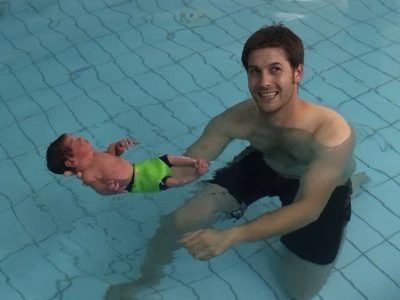
Baby swimming in the bath
If parents decide to train their toddler at home, they need to prepare a bath for training in advance. Before each lesson, the bath should be thoroughly washed with laundry soap, and cleaned with baking soda once every two weeks. After cleaning, it must be rinsed with plenty of water.
Potassium permanganate solution and aggressive cleaning chemicals cannot be used. Since these substances still remain on the surface of the bathroom and can enter the child’s body. In addition, solutions of medicinal herbs should not be added to swimming water. The water must be clean.
Water temperature indicators
The water temperature must be carefully monitored. During the first training sessions, its readings should not exceed 36 degrees. They should be reduced slowly and gradually. Acceptable minimum values are 32 degrees. During classes, you need to monitor the child’s reaction; he should feel comfortable in the water. Water procedures will help the baby not only strengthen the body, but will also have a positive effect on the immune system.
When training, the baby must be completely immersed in water, and also monitor his reaction:
- If, after immersing the little one in the water, the mother sees that he begins to whine, but after about a minute he stops, then the temperature of the water is ideal;
- The child does not stop whining after diving, which means the water is too cold for him;
- If the little one feels relaxed and does not show activity, then this is evidence that the water is too warm.
From the baby’s reaction from the first minutes, you can understand whether the environment created for training is suitable for him or not.

Infant swimming in the bathtub. Infant swimming rules.
- Suitable age. You cannot teach a newborn to swim in the bathtub immediately after birth. A baby should be taught to swim and dive from 3 to 4 months of age, when the umbilical cord has completely healed. The baby must at least get used to the new environment and unusual living conditions. At four months, the baby is already quite strong and tall, but has not yet forgotten about the swimming instinct.
- Preparing the bathroom. You should not start your first water activity in the pool. A child may be afraid of unfamiliar people and strange rooms. It is better to start exercising in a calm and relaxing home environment. Before filling the bathtub with warm water, you must wash it thoroughly with ordinary laundry soap. It is not recommended to use extracts of medicinal plants or potassium permanganate for bathing babies. When a child swims, he may accidentally swallow water with additives and become poisoned. Once a week, the bathtub in which the baby is bathing should be cleaned with soda.
- Optimal water temperature. It is advisable to carry out the first exercises at a water temperature of +35°C. When the baby gets a little used to swimming, you can use slightly colder water. But the mother needs to remember that a newborn baby cannot be bathed at temperatures below +32°C. It is easy to understand how comfortable a baby feels in the bath by his behavior. If the baby cries heart-rendingly, without stopping, when immersed in water, then he is cold, but if, on the contrary, he is silent and looks lethargic, then he is too hot. The temperature is ideal when the baby is cheerfully and actively waving its arms and legs. While the child is bathing in the bath, the water slowly cools, but it is not necessary to return it to the original temperature. It is useful for a newborn baby to harden up.
How to accustom a child to water and teach him to swim?
You can teach your baby to swim at home on your own or go with him to the children's center and visit the pool there. Home classes are convenient because they are free and accessible at any time. The advantages of visiting the pool are that a professional instructor will work with your little one, which means such training will bring him much more benefit than home training. To choose the appropriate option, you should consider each of them in more detail.
Infant swimming in the pool
The duration of classes with infants in the pool is 45 minutes. Group classes are usually held, but they can also be individual. To decide which one is better to choose, experts advise visiting both, looking at the baby’s reaction.
For the first lesson, the instructor must bring a certificate from the pediatrician stating that the infant has no contraindications for swimming.
Classes for infants in the pool consist of the following stages:
- First, the coach or parents warm up with the child on land;
- Then the training takes place at the side of the pool. Gymnastic exercises are performed;
- Next, the lesson moves on to swimming on a board, with rings or other devices;
- The training ends with games involving the development of special diving techniques.
After about a month of such activities, the baby will behave confidently in the water and not be afraid, as he was in the first weeks of visiting the pool.

Swimming lessons in the pool for children
Swimming lessons in the pool for children can be divided into recreational and sports. Even if you have enrolled your child in the section, for the first year he will engage in recreational swimming. This is necessary to build muscle mass, familiarize yourself with the technique and adapt the body to frequent exposure to water.
When exercising in a swimming pool, the following side effects may occur due to the high chlorine content:
- Skin rashes and peeling;
- Inflammatory diseases of the respiratory tract.
If after exercising in the pool you notice these manifestations in your child, consult a doctor; you may need to change the pool or choose a different sport for him.
Infant swimming at home
You can teach your toddler to swim at home, especially since there is a special set of exercises created for home exercises. It is necessary to start classes by introducing the baby to water. First you need to hold the child above its surface, making sure that he touches it with his palms. Then you need to dip your feet in it and hold them under water for several minutes. Next, you should completely immerse the baby’s body, holding it in a column.
During classes with the little one, you need to talk affectionately, smile at him and pour water on him. The baby can be supported under the back of the head and under the chin while swimming. The first type of support is used for swimming on the back, and the second for swimming on the stomach. You can master one of these techniques, but it is better to master two at once, so that you can alternate them later and get more benefits from water procedures.
To make the baby feel more relaxed, he needs to wear a support circle, which will serve as additional protection.
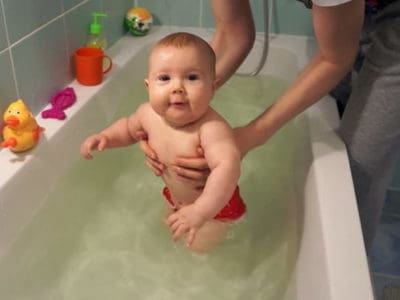
Exercises for infant swimming
Swimming for newborns is not only about immersing the child in water with established temperature indicators. Its goal is to perform a certain set of exercises. They are completely safe for the child’s body and easy to perform.
In the process of exercising with the toddler, parents will be able to understand which exercises their child likes more and which ones less. Adults, when training with a child in an aquatic environment, must be focused and remain calm so that their child also feels confident.
Below we will give the necessary set of exercises that will make swimming useful and strengthen the baby’s body.
splashing
With one hand you need to hold the baby's chin, placing it above the water on his stomach, and with the other you should slap the water to show him how it diverges in circles and trembles. By performing different movements with your hand in the water, you can attract the attention of the little one and relieve tension. He should also be shown how water flows from his hand and drips.
After a few lessons, the child will be able to splash around in the bath independently and without fear, while receiving a lot of positive emotions. This exercise must be performed until the baby gets used to the water. Only after he has become comfortable in the aquatic environment can he move on to other exercises.
Turns and pushes
While swimming, from time to time you need to bring the baby closer to the walls of the bath so that he rests his feet on them, pushes off and swims further. When turning over, the child must be supported, but participation in this process must be minimal.
The baby should feel the connection between the force of his repulsion from the sides and the distance that he manages to swim after the push. Almost all toddlers like this exercise and they do it with pleasure.
Straight swimming
The child must be placed on his stomach, supported under the chin. You should place a bright toy in front of him that will arouse his interest. The toy needs to be pushed away from the child so that he tries to swim towards it. With each push of the child, the toy needs to be moved further away, changing the speed and technique of the little swimmer’s movement.
Gradually, the intensity of support needs to be weakened so that the baby understands that he needs to swim on his own, trying to keep his body on the water.
Figure eight swimming
You should move on to this exercise only when the child has mastered straight swimming. In order to teach a toddler to swim using this technique, you need to alternately hold him on his stomach, then on his back, drawing various figures on the water, including figure eights.
Until the optimal speed of the exercise is selected for the child, various options should be used. Some children like fast movement, while others prefer smoothness and leisurely movement.
Wiggle
To perform this exercise, the baby should be placed on his stomach, supporting him by the chin. You need to hold your head so that it is above the surface of the water. The child should be moved from top to bottom and back and forth, immersing him in the water and lifting him out of it, imitating swinging on a swing.
A similar exercise is used to prepare the baby for diving. It should be performed for about a month, without trying to move on to the most difficult task, as the baby may get scared and begin to perceive water procedures as something scary and unpleasant.
Teaching your baby to dive
It is difficult to teach a toddler to dive and you need to move on to this stage of training only when the baby has mastered all of the above techniques. When starting to learn diving, parents should understand that the baby has the skills and reflexes of holding his breath, so you should not be afraid to immerse your little one in the water.
You need to perform this exercise starting with preparation. The baby needs to be given a clear command to “dive” and at the same time blow in the face. He will immediately hold his breath and close his eyes. In order for him to get used to it, this exercise must be performed for ten days. Then the exercise needs to be complicated. After the command “dive”, the baby needs not only to blow, but also to splash water in the face.
When he has mastered the preparation, he can proceed directly to diving. First you need to immerse the little one for two seconds, and then, over time, increase the duration of being under water to thirty seconds.
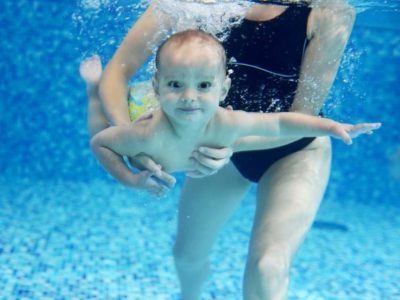
Features of infant swimming
Many parents are well aware of the possibility of conducting water activities with their infants. But not all mothers and fathers are delighted with this idea. It is very strange and unusual to watch a newborn baby calmly and freely move its arms and legs in the water. Adults consider the aquatic environment unnatural for human life, and even dangerous for a small child. But is this really so?
It is worth remembering that for nine months the embryo floats in the fetal fluid, which is a reliable protective shell for it from adverse external influences and a supplier of nutrients. Therefore, for a newly born baby, the water environment is more natural and pleasant than air.
A newborn baby perceives the air space as something foreign and heavy, forcing him to breathe on his own. For a few more weeks after birth, the baby retains the instinct of swimming, which allows him to float perfectly on the surface of the water and dive without suffocating.
This amazing behavioral feature of an infant is used by medical specialists for developmental and therapeutic purposes. Pediatricians assure that infant swimming allows a newborn not to forget about the swimming instinct, and even develop it even more. Healthy swimming for infants is used for the effective prevention and treatment of childhood diseases, promotion of health and full development of the newborn baby.
Pediatricians' opinion
Pediatricians speak differently about infant swimming. Children's doctor Komarovsky, known to many mothers, claims that children who swim from infancy develop faster than their peers mentally and physically. In addition, exercises performed in an aquatic environment bring invaluable benefits to the child’s body and strengthen the muscular system.
However, infant swimming makes many babies hyperactive and, if they have problems with the respiratory system, they increase the risk of bronchitis and pneumonia.
But despite this, those parents who swim with their children from birth observe only positive results. They note that their babies sleep better, eat better and adapt more quickly to the established daily routine. In addition, most infants really enjoy training in an aquatic environment and receive positive emotions from it.
You should also take into account the fact that children and parents interact with each other during such activities, significantly increasing spiritual closeness and the level of trust, which is not the case for those kids whose parents decided not to engage in infant swimming with their child.
Who should not do infant swimming?
For some children, training in the aquatic environment is prohibited altogether or for some time.
To find out whether your baby can start infant swimming, you need to go to the pediatrician and get examined. You should avoid training in water if your child has:
- Inflammatory process in the acute stage with increased temperature;
- Ailments of infectious or viral etiology;
- Diseases of the musculoskeletal system requiring fixation of the upper or lower extremities;
- Purulent processes;
- Progressive liver or kidney failure;
- Skin diseases;
- Heart failure;
- Epileptic seizures;
- Open wounds.
The pediatrician will be able to determine contraindications to swimming after a complete examination of the child.
